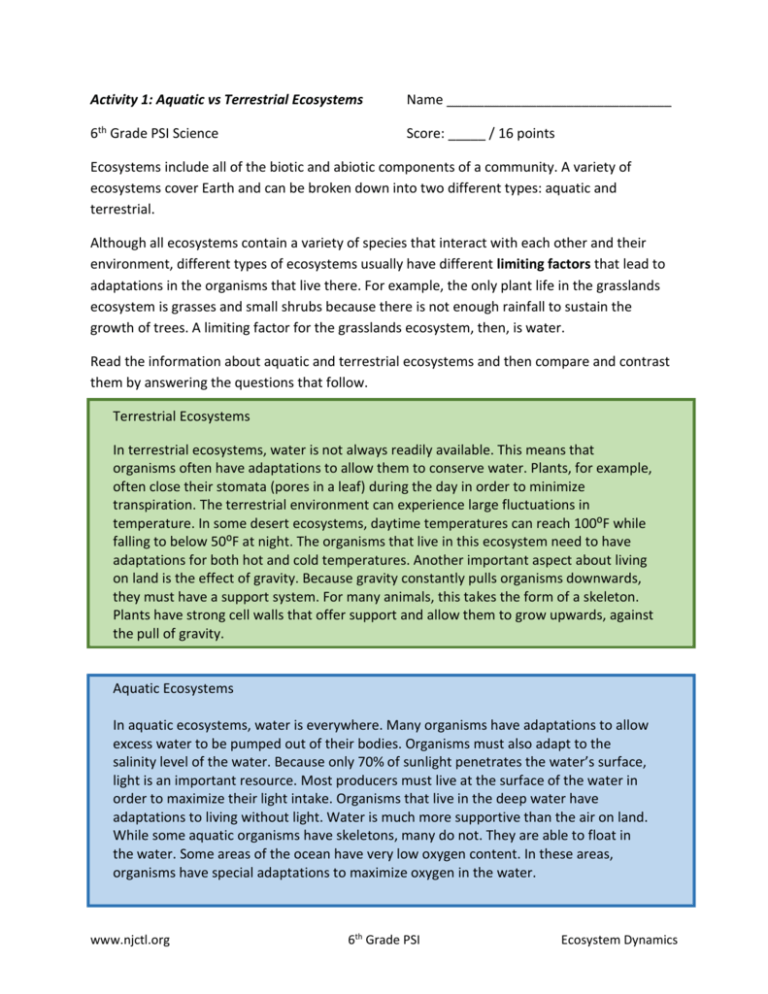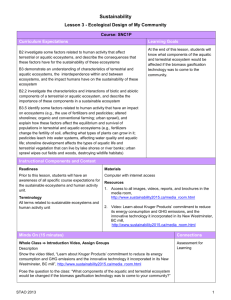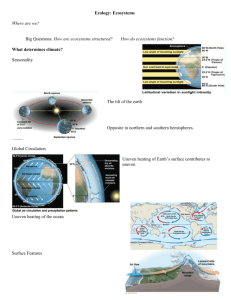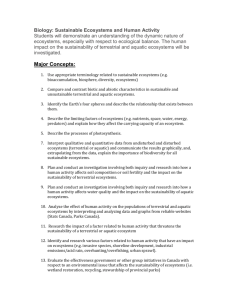Aquatic vs. Terrestrial Ecosystems Worksheet
advertisement

Activity 1: Aquatic vs Terrestrial Ecosystems Name ______________________________ 6th Grade PSI Science Score: _____ / 16 points Ecosystems include all of the biotic and abiotic components of a community. A variety of ecosystems cover Earth and can be broken down into two different types: aquatic and terrestrial. Although all ecosystems contain a variety of species that interact with each other and their environment, different types of ecosystems usually have different limiting factors that lead to adaptations in the organisms that live there. For example, the only plant life in the grasslands ecosystem is grasses and small shrubs because there is not enough rainfall to sustain the growth of trees. A limiting factor for the grasslands ecosystem, then, is water. Read the information about aquatic and terrestrial ecosystems and then compare and contrast them by answering the questions that follow. Terrestrial Ecosystems In terrestrial ecosystems, water is not always readily available. This means that organisms often have adaptations to allow them to conserve water. Plants, for example, often close their stomata (pores in a leaf) during the day in order to minimize transpiration. The terrestrial environment can experience large fluctuations in temperature. In some desert ecosystems, daytime temperatures can reach 100⁰F while falling to below 50⁰F at night. The organisms that live in this ecosystem need to have adaptations for both hot and cold temperatures. Another important aspect about living on land is the effect of gravity. Because gravity constantly pulls organisms downwards, they must have a support system. For many animals, this takes the form of a skeleton. Plants have strong cell walls that offer support and allow them to grow upwards, against the pull of gravity. Aquatic Ecosystems In aquatic ecosystems, water is everywhere. Many organisms have adaptations to allow excess water to be pumped out of their bodies. Organisms must also adapt to the salinity level of the water. Because only 70% of sunlight penetrates the water’s surface, light is an important resource. Most producers must live at the surface of the water in order to maximize their light intake. Organisms that live in the deep water have adaptations to living without light. Water is much more supportive than the air on land. While some aquatic organisms have skeletons, many do not. They are able to float in the water. Some areas of the ocean have very low oxygen content. In these areas, organisms have special adaptations to maximize oxygen in the water. www.njctl.org 6th Grade PSI Ecosystem Dynamics 1. List three abiotic factors for terrestrial ecosystems. 2. List three abiotic factors for aquatic ecosystems. 3. What is a limiting factor for each ecosystem? a. Terrestrial ecosystem: b. Aquatic ecosystem: 4. In your quest to study ecosystems throughout the world, you discover several new species. Listed below are partial descriptions of each new species. Determine if each was discovered in a terrestrial or an aquatic ecosystem. Below each description, explain your reasoning. a. ____________________ A short plant that is covered in tiny hairs that insulate against extreme cold and heat. __________________________________________________________________ __________________________________________________________________ b. ____________________ An organism that looks like a gelatinous blob with seemingly no structure. __________________________________________________________________ __________________________________________________________________ c. ____________________ An organism that has very large eyes but is essentially blind. Its other senses, such as touch and smell, are highly developed. __________________________________________________________________ www.njctl.org 6th Grade PSI Ecosystem Dynamics __________________________________________________________________ d. ____________________ A small animal that buries itself under the ground. When water is present, it comes out and lays eggs. When water disappears, it goes back underground. __________________________________________________________________ __________________________________________________________________ www.njctl.org 6th Grade PSI Ecosystem Dynamics











